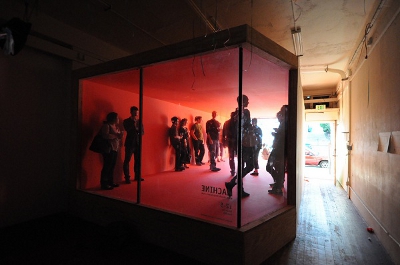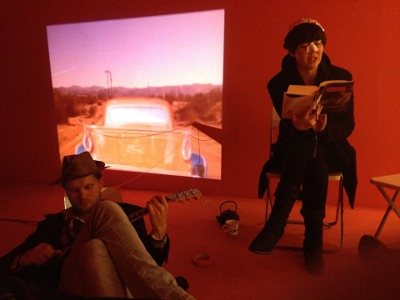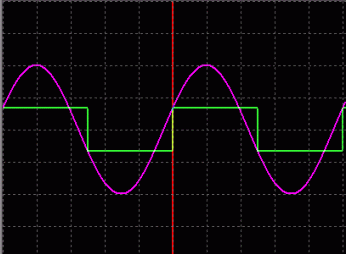Interview with Nate Page
Discussion between Nate Page & Mark Allen about the Storefront Plaza installation. (March 3rd, 2012)
Mark Allen: Can you talk about the genesis of the idea for Storefront Plaza?
Nate: It began with an invitation to transform the space in some way. I became interested on the idea of the threshold, of a boundary between the outside and the inside, and how to make the threshold experience linger or resonate over time. I focused on the idea of a threshold being the transition of a surface to a volume, like a boundary opening up to a three-dimensional space.
Mark: At Machine, we’ve developed a tendency of inviting our space to be transformed into different ecosystems. I think that your piece and Christy McCaffrey and Sara Newey’s The Forest and Josh Beckman’s Sea Nymph shipwreck installation are like that.
Nate: There’s that issue between responding to a site because of its basic site characteristics, versus responding to a site because of its social and cultural context, and the specifics of how it operates.
Mark: Like the architectural site versus the dynamics of the people at that site?
Nate: Yeah. I’d say the first piece that I did at Machine [The Machine Subject Object Project] was responding to how Machine operates socially. That response became a physical transformation that sort of represented or became a metaphor for the social dynamics.
Mark: One of the things that’s interesting about Storefront Plaza is that it’s a piece in a gallery and it’s a public art piece, depending on which side of the glass you’re on. Did it function how you imagined it, in terms of how artists used it or didn’t use it, or how the public interacted with it?

Nate: Brett Masley had this perception that I had made a white cube, because anything you put inside it became super highlighted. I liked thinking of it more as a proposition that became physical. It’s largely non-proscriptive, but its nature invites human interaction, though it doesn’t say what kind. I was interested in how things would unfold, how people would use it, how they would respond to it, or not.
Mark: I sometimes see the Machine storefront as a weird chameleon. There are a ton of dramatic changes but then all of a sudden it blends into the background. All the time, people tell me, “I’ve lived in the neighborhood for years and I’ve never seen this before.” During Storefront, I overheard a passerby saying, “oh, Machine’s gone.” Like a bomb had exploded and blown out the storefront space. I was fascinated with the idea that your installation was a transformation that produced a void.
Nate: We talked about the void space in the beginning. It is sort of related to a chameleon, in that it’s this one thing that can constantly change, depending on the context.
Mark: How did the idea of curating a series of events at night come about?
Nate: I liked how it looked at night, when the lights were on, and everything else around it was quiet and kind of dead. It had this strong glowing presence. That, coupled with how I’d felt like its audience was more of the general public: people driving by or walking on the street, even across the street, on the other side, who are on the side of the civic perspective rather than the commercial storefront perspective.
I also felt like the overnights were a way to produce something specifically for random public people. You know, the drunk guy walking home at 2:30 in the morning, or a couple coming home from dinner. There’s nothing else around them, they just slow down, and it’s a different headspace to consider things.

Mark: It worked like a conceptual force-field that people walked into, and maybe got stuck in or slowed down for awhile. For example, when Carmina Escobar advertised free sonic massage. One person after another came in, like flies in a flytrap. Somebody on their way to buy cigarettes at the gas station was all of a sudden, standing in the storefront, kind of on a stage, with Carmina singing into their bones. Literally making their bones resonate.
There’s a corollary of the idea of it being a white cube and making everything in it look dramatic, but also that it was impossible to have a focused experience of a performance. It’s much more suited to wandering by, seeing something, maybe having an intimate one-on-one experience. It worked like the opposite of a concert hall. A concert hall is the machine for focusing your attention on performance. Your piece was like a machine for focusing your attention on everything happening around the performance.
This happened with Johanna Hedva’s piece, where she and Pall Haukur read Casanova’s memoirs out loud, dressed like Tycho Brahe and Gram Parsons. It had these weirdly comic but minimal elements that worked from a compositional perspective. It wasn’t so much about paying close attention to what she was reading, but worked as this amazing visual arrangement for people walking by.

The Plaza created a type of stage that worked like a porous tableau vivant, a staged theatrical space that people could casually step into and out of. The pieces invited and allowed people to wander in and out, with varying degrees of attention.
Nate: That brings me to the idea we spoke about, of figuring out a way to create programming with that type of looseness.
Mark: Yeah. I love the idea of the “infin-event,” and of creating a series of a lot of them. The thing I find so exciting is this idea of public space or public interaction as an extension of a studio practice. It’s expanding the idea of the studio as the place where the work is developed. Public space could serve that function.
If people were doing stuff every night at Machine for a year, between ten and twelve, it stops being about, “Here are the three great events I’ve curated this week.” It’s more like a space for continuous research and development.
Nate: Yeah. I really liked the convergence of all these different activities: you’d be working with a group of people in the day, then I would start to come in with my nighttime people, and sometimes someone else was meeting. There were multiple things being produced at the same time.
Mark: It’s like the difference between a square wave and a sine wave. In synthesizer design there are waveforms, and each have a specific sound to them. The most basic waveform is a square wave, which is basically something being turned on and off. Imagine a graph, where the vertical axis is something either on or off, and the horizontal axis is time. Something goes on, stays on for a second, goes off for a second, goes on for a second—the waveform it produces is of a very hard sound. That’s a square wave. With a sine wave, you ramp up, and you ramp back down, so it has curves and different corresponding sound characteristics.

For a long time, Machine’s model has been a square wave: something intense is happening, then nothing is happening. The sine wave model is more like having things always going on, with various peaks in intensity.
And if you think about overlaying different waveforms, you get a more complex sound. It’s like the pieces you’re doing and I’m doing and somebody else is doing start to overlap in the space. So, there’s a continuous energy coming out of Machine.
Nate: Yeah, I’m excited about that. I also see Machine bringing in people for administrative things, like documentation or writing, who experiment with the format so it becomes their own artistic “wave.” All of a sudden everything that’s operating in Machine is becoming like its own sort of wave.
It’s like a metaphor for how the sun works. The sun is a complex and constantly generating a totalizing life force, and everything on Earth is developed from that. It’s a combustion process. With Machine firing on all these different levels, it generates rays of people’s projects that generate other future projects, and on and on.
Mark: Right. You started to operate like this with Storefront, by curating the overnights. Had you done a curatorial project like this before?
Nate: No.
Mark: It was more like being an inviter than a curator in some ways, right?
Nate: Inviter is a good term. I wasn’t trying to make any kind of curatorial statement.
Mark: Yeah. The idea of inviting people is very expansive, whereas the word curator could suggest reductive-ness. Like, “there’s too much stuff, so I’m going to pick the good stuff for people to see.”
Nate: Right. I never thought about all the projects in their totality as a certain body.
Mark: It seems like a similar process to Liz Glynn’s Black Box series. She was saying, “I just invited people, and I didn’t try to think about what they were doing, or the quality of what they were doing, or what they should be doing.”
Nate: That’s interesting. Because both of our art-making practices are space- or event-making somehow. We create a context, and have total control over it, but then we just want to see that context run on its own.
Mark: I did a studio visit with you, maybe two years ago, maybe even three. You were making work in the studio. Are you still doing that?
Nate: Yeah. I don’t know exactly why I do that, but I do.
Mark: Do you feel like it’s research for larger projects, or do you feel like it’s its own distinct thing?
Nate: In a way it turns out to be research for other projects. It’s more like a processing place for where my ideas are going. It’s like the language that I know, that I was trained in to process ideas. But, of course, being trained in that language also means being trained to think that that stuff is valuable. Going to galleries and museums is still there, too. There’s always this kind of this hope, like “Oh yeah, this it. This is the one that’s going to sell for $50,000.”
Mark: It’s interesting to see people who have studio practices, and then larger more public pieces, or that aren’t “material” in the same sense.
Nate: Yeah, I love galleries. They’re like a kind of home or something. Like when you see them on holidays, you still love them. But you don’t have to make your life all about them.